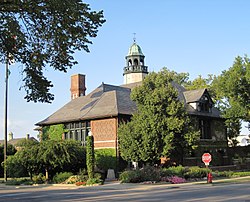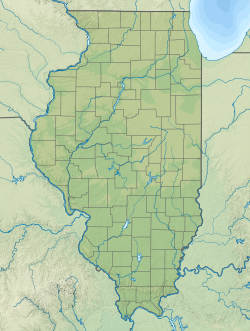
Lake County is situated in the northeastern corner of the U.S. state of Illinois, along the shores of Lake Michigan. As of the 2020 census, it has a population of 714,342, making it the third-most populous county in Illinois. Its county seat is Waukegan, the tenth-largest city in Illinois. The county is primarily suburban, with some urban areas and some rural areas. Due to its location, immediately north of Cook County, Lake County is one of the collar counties of the Chicago metropolitan area. Its northern boundary is the Wisconsin state line.
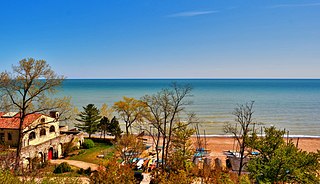
Glencoe is a lakefront village in northeastern Cook County, Illinois, United States. As of the 2020 census, the population was 8,849. Glencoe is part of Chicago's North Shore and one of the wealthiest communities in Illinois.

Lemont is a village located in Cook, DuPage, and Will counties in the U.S. state of Illinois, and is a south-west suburb of Chicago. The population was 17,629 as of the 2020 census. The village is situated on a hillside along the south banks of the Des Plaines River. It overlooks Waterfall Glen's Midwestern Bluff Savanna on the opposite side. Lemont is home to Argonne National Laboratory and other heavy industrial sites, and has a substantial European immigrant population.
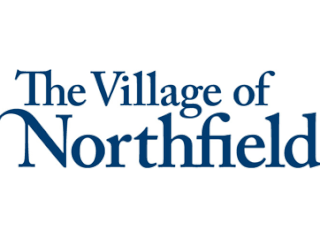
Northfield is a village in Cook County, Illinois, United States, located approximately 19 miles (31 km) north of downtown Chicago. As of the 2020 census, the village's population was 5,751. It is part of a collection of upscale residential communities north of Chicago that belong to New Trier and Northfield Townships and the greater North Shore.

Oak Brook is a village in DuPage County, Illinois, United States. The population was 8,163 at the 2020 census.

River Forest is a suburban village adjacent to Chicago in Cook County, Illinois, United States. Per the 2020 census, the population was 11,717. Two universities make their home in River Forest, Dominican University and Concordia University Chicago. The village is closely tied to the larger neighboring community of Oak Park. There are significant architectural designs located in River Forest such as the Winslow House by Frank Lloyd Wright. River Forest has a railroad station with service to Chicago on Metra's Union Pacific West Line.

Grayslake is a village in Lake County, Illinois, United States. It is located in the Chicago metropolitan area, about 40 miles (64 km) north of Chicago's downtown, 14 miles (23 km) west of Lake Michigan, and 15 miles (24 km) south of the Wisconsin border. The village's population at the 2020 census was 21,248.

Green Oaks is a village in Libertyville Township, Lake County, Illinois, United States. Per the 2020 census, the population was 4,128.

Gurnee is a village and suburb in Lake County, Illinois, United States. Its population was 30,706 as of the 2020 census. It borders the city of Waukegan, and is a popular tourist attraction within the Chicago metropolitan area.
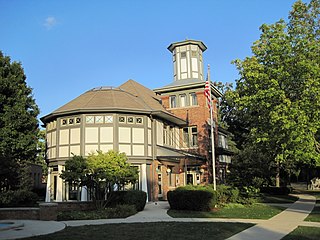
Lake Bluff is a village in Lake County, Illinois, United States. Per the 2020 census, the population was 5,616.

Libertyville is a village in Lake County, Illinois, United States, and a northern suburb of Chicago. It is located 5 miles (8 km) west of Lake Michigan along the Des Plaines River. The 2020 census population was 20,579. It is part of Libertyville Township, which includes the village, neighboring Green Oaks, and portions of Vernon Hills, Mundelein, unincorporated Waukegan and Lake Forest, and part of Knollwood CDP. Libertyville neighbors these communities as well as Gurnee to the north and Grayslake to the northwest. Libertyville is about 40 miles north of the Chicago Loop and is part of the United States Census Bureau's Chicago combined statistical area (CSA).

Mettawa is a village in Lake County, Illinois, United States. Per the 2020 census, the population was 533. The village maintains trails for pedestrian, bicycle and equestrian usage. Five forest preserves of the Lake County Forest Preserve District are located within village boundaries.

North Chicago is a city in Lake County, Illinois, United States, and a suburb of the Chicago metropolitan area. The population was 30,759 at the 2020 census making it the third-most populous city by population in the county, after Waukegan and Mundelein.
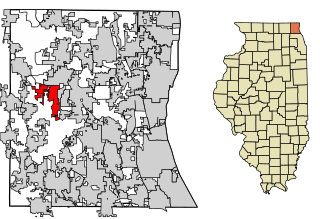
Round Lake is a northern suburb of Chicago in Lake County, Illinois, United States. Per the 2020 census, the population was 18,721.

Vernon Hills is a suburb north of Chicago, Illinois in Lake County, Illinois, United States. The population was 26,850 at the 2020 census. Vernon Hills serves as a retail hub for its surrounding area.

The North Shore consists of many affluent suburbs north of Chicago, Illinois, bordering the shores of Lake Michigan. These communities fall within suburban Cook County and Lake County. The North Shore's membership is often a topic of debate, and it includes some Chicago suburbs which do not border Lake Michigan. However, Lake Bluff, Lake Forest, Highwood, Highland Park, Deerfield, Glencoe, Northbrook, Northfield, Winnetka, Kenilworth, Wilmette, Golf, Glenview, Niles, Morton Grove, Skokie, and Evanston, are generally considered to be the main constituents of the North Shore. The North Shore is known for its affluence, high level of education, proximity to Chicago, and top-rated public schools.
Knollwood is an unincorporated community and census-designated place (CDP) in Lake County, Illinois, United States. Per the 2020 census, the population was 2,221. It is located within Shields Township and Libertyville Township. Knollwood shares a ZIP Code with the neighboring village of Lake Bluff, and children attend Lake Bluff schools. The residents of Knollwood were served by the Knollwood Fire Department until October 2018, after the trustees of the Rockland Fire Protection District ended their relationship with the department. Residents now receive fire protection from the Libertyville and Lake Forest fire departments. Police protection is provided by the Lake County Sheriff's Department.

Rondout is an unincorporated community in Lake County, Illinois, United States that first formed around a railroad junction. The area is located within Libertyville Township. As Rondout is an unincorporated community rather than a municipality, it lacks clearly defined borders, and shares postal codes with Lake Bluff, Lake Forest and Libertyville, Illinois. It has its own elementary school which comes under Rondout School District 72. Illinois Route 176 passes east–west through Rondout, serving as the "main street" of the community, where it is also called "Rockland Road".

Libertyville Township is a township in Lake County, Illinois, United States. As of the 2010 census, its population was 53,139. The village of Libertyville is part of the township, as are parts of Green Oaks, Lake Bluff, Lake Forest, Mettawa, Mundelein, North Chicago, Rondout, Vernon Hills and Waukegan.

Highland Park is a suburban city located in the southeastern part of Lake County, Illinois, United States, about 25 miles (40 km) north of downtown Chicago. Per the 2020 census, the population was 30,176. Highland Park is one of several municipalities located on the North Shore of the Chicago metropolitan area.
